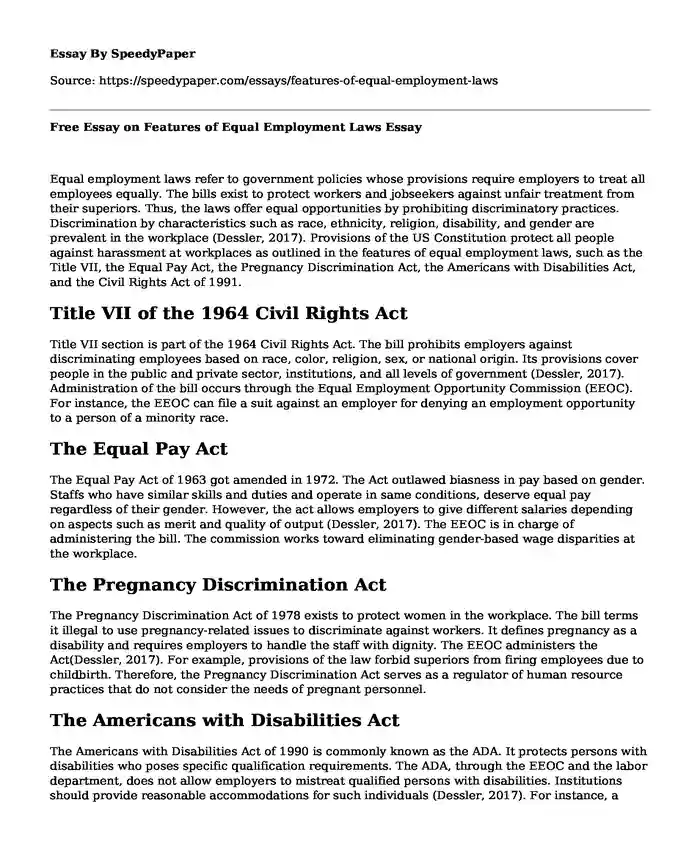
| Type of paper: | Essay |
| Categories: | Discrimination Human rights Employment law |
| Pages: | 3 |
| Wordcount: | 635 words |
Equal employment laws refer to government policies whose provisions require employers to treat all employees equally. The bills exist to protect workers and jobseekers against unfair treatment from their superiors. Thus, the laws offer equal opportunities by prohibiting discriminatory practices. Discrimination by characteristics such as race, ethnicity, religion, disability, and gender are prevalent in the workplace (Dessler, 2017). Provisions of the US Constitution protect all people against harassment at workplaces as outlined in the features of equal employment laws, such as the Title VII, the Equal Pay Act, the Pregnancy Discrimination Act, the Americans with Disabilities Act, and the Civil Rights Act of 1991.
Title VII of the 1964 Civil Rights Act
Title VII section is part of the 1964 Civil Rights Act. The bill prohibits employers against discriminating employees based on race, color, religion, sex, or national origin. Its provisions cover people in the public and private sector, institutions, and all levels of government (Dessler, 2017). Administration of the bill occurs through the Equal Employment Opportunity Commission (EEOC). For instance, the EEOC can file a suit against an employer for denying an employment opportunity to a person of a minority race.
The Equal Pay Act
The Equal Pay Act of 1963 got amended in 1972. The Act outlawed biasness in pay based on gender. Staffs who have similar skills and duties and operate in same conditions, deserve equal pay regardless of their gender. However, the act allows employers to give different salaries depending on aspects such as merit and quality of output (Dessler, 2017). The EEOC is in charge of administering the bill. The commission works toward eliminating gender-based wage disparities at the workplace.
The Pregnancy Discrimination Act
The Pregnancy Discrimination Act of 1978 exists to protect women in the workplace. The bill terms it illegal to use pregnancy-related issues to discriminate against workers. It defines pregnancy as a disability and requires employers to handle the staff with dignity. The EEOC administers the Act(Dessler, 2017). For example, provisions of the law forbid superiors from firing employees due to childbirth. Therefore, the Pregnancy Discrimination Act serves as a regulator of human resource practices that do not consider the needs of pregnant personnel.
The Americans with Disabilities Act
The Americans with Disabilities Act of 1990 is commonly known as the ADA. It protects persons with disabilities who poses specific qualification requirements. The ADA, through the EEOC and the labor department, does not allow employers to mistreat qualified persons with disabilities. Institutions should provide reasonable accommodations for such individuals (Dessler, 2017). For instance, a store manager can install ramps to ease the movement of people on wheelchairs. The ADA, however, does not cover disabilities that do not affect one's daily life activities. Regardless, the law plays a significant role in protecting the rights of the disabled.
The Civil Rights Act of 1991
The Civil Rights Act of 1991 aimed to cement equal employment laws by holding employers more accountable. A series of verdicts by the Supreme Court did not favor minority communities. Thus, legislators drafted a new bill. The burden of proof section requires an employer to prove the necessity of meeting specific qualifications. The money damages segment empowered discriminated persons to file for compensatory or punitive damages(Dessler, 2017). The mixed motive part made it unlawful to sack employees due to their suspicious behavior. Thus, the bill' guidelines made it difficult for managers to avoid taking responsibility for their actions.
In conclusion, equal employment laws are crucial for regulating the workplace environment. The various policies protect different groups against unlawful, discriminatory human resource practices. The EEOC agency is the primary enforcer of most of these guidelines. Consistent enforcement of the fair opportunity provisions is necessary to create a healthy work environment. It is essential to uphold fairness and dignity in all institutions regardless of differences such as race and gender.
References
Dessler, G. (2017). Human Resources Management (15th ed.). Boston: Pearson.
Cite this page
Free Essay on Features of Equal Employment Laws. (2022, Nov 09). Retrieved from https://speedypaper.com/essays/features-of-equal-employment-laws
Request Removal
If you are the original author of this essay and no longer wish to have it published on the SpeedyPaper website, please click below to request its removal:
- Google Corporate Strategy - Essay Example
- Analysis of Nepalese Foods - Photo Essay Sample
- Free Essay on the Opera Monteverdi Tu se morta from Orfeo and Purcell Didos lament
- Essay Example on How Family Violence Is Related to Child Abuse and Maltreatment
- Essay Sample Discussing Alternatives to the Problem of Youth Homelessness
- American History Essay Example: Slavery and Civil War
- Literary Essay Sample: Aeschylus' Persians and Other Stories
Popular categories




